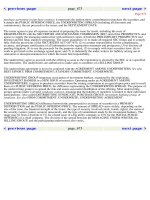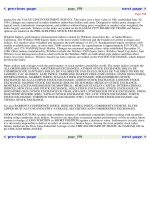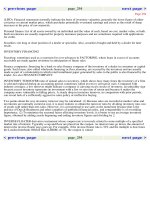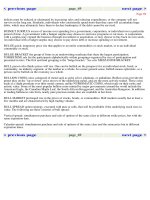Fluids electrolytes made incredibly easy, 5th edition
Bạn đang xem bản rút gọn của tài liệu. Xem và tải ngay bản đầy đủ của tài liệu tại đây (12.84 MB, 551 trang )
:
Title: Fluids & Electrolytes made Incredibly Easy!®, 5th Edition
Copyright ©2011 Lippincott Williams & Wilkins
> Front of Book > Authors
Contributors and consultants
Cheryl L. Brady RN, MSN
Assistant Professor of Nursing Kent State University Salem, OH
Shelba Durston RN, MSN, CCRN
Nursing Instructor San Joaquin Delta College Stockton, CA
Laura R. Favand RN, MS, CEN
Deputy Chief Nurse U.S. Army Cadet Command Ft. Knox, KY
Margaret M. Gingrich RN, MSN
Professor Harrisburg Area Community College Harrisburg, PA
Karla Jones RN, MS
Associate Professor University of Alaska, Anchorage Anchorage, AK
Patricia Lemelle-Wright RN, MS
Staff Nurse/Clinical Instructor University of Chicago Hospital Malcolm X College Chicago,
IL Moraine Valley College Palos Hill, IL
Linda Ludwig RN, BS, MEd
Practical Nursing Instructor Canadian Valley Technology Center El Reno, OK
Rexann G. Pickering RN, BSN, MS, MSN, PhD, CIP, CIM
Administrator, Human Protection Methodist Healthcare Memphis, TN
Alexis Puglia RN
Staff Nurse—Clinical Nurse III Chestnut Hill Hospital Philadelphia, PA
Roseanne Hanlon Rafter MSN, RN, GCNS, BC
Director
Professional Nursing Practice Chestnut Hill Hospital Philadelphia, PA
Donna Scemons PhD, RN, FNP-C, CNS
President Healthcare Systems, Inc. Castaic, CA
Vanessa M. Scheidt RN, TNS, PHRN, FF2
EMS Coordinator St. James Hospital & Health Centers Olympia Fields, IL
Allison J. Terry PhD, MSN, RN
Director
Center for Nursing Alabama Board of Nursing Montgomery, AL
Leigh Ann Trujillo RN, BSN
Nurse Educator St. James Hospital and Health Centers Olympia Fields, IL
:
Title: Fluids & Electrolytes made Incredibly Easy!®, 5th Edition
Copyright ©2011 Lippincott Williams & Wilkins
> Front of Book > Not Another Boring Foreword
Not Another Boring Foreword
If you're like me, you're too busy to wade through a foreword that uses pretentious terms
and umpteen dull paragraphs to get to the point. So let's cut right to the chase! Here's
why this book is so terrific:
1. It will teach you all the important things you need to know about fluids and
electrolytes. (And it will leave out all the fluff that wastes your time.)
2. It will help you remember what you've learned.
3. It will make you smile as it enhances your knowledge and skills.
Don't believe me? Try these recurring logos on for size:
Memory jogger!—helps you remember and understand difficult concepts
Uh-oh—lists dangerous signs and symptoms and enables you to quickly
recognize trouble
It's not working—helps you find alternative interventions when patient
outcomes aren't what you expected
Chart smart—lists critical documentation elements that can keep you out of
legal trouble
Teaching points—provides clear patient-teaching tips that you can use to
help your patients prevent recurrence of the problem
Ages and stages—identifies issues to watch for in your pediatric and geriatric
patients.
That's a wrap!—summarizes what you've learned in the chapter
See? I told you! And that's not all. Look for me and my friends in the margins throughout
this book. We'll be there to explain key concepts, provide important care reminders, and
offer reassurance. Oh, and if you don't mind, we'll be spicing up the pages with a bit of
humor along the way, to teach and entertain in a way that no other resource can.
I hope you find this book helpful. Best of luck throughout your career!
Joy
:
Title: Fluids & Electrolytes made Incredibly Easy!®, 5th Edition
Copyright ©2011 Lippincott Williams & Wilkins
> Table of Contents > Part I - Balancing basics > 1 - Balancing fluids
1
Balancing fluids
Just the facts
In this chapter, you'll learn:
♦ the process of fluid distribution throughout the body
♦ the meanings of certain fluid-related terms
♦ the different ways fluid moves through the body
♦ the roles that hormones and kidneys play in fluid balance.
A look at fluids
Where would we be without body fluids? Fluids are vital to all forms of life.
They help maintain body temperature and cell shape, and they help transport
nutrients, gases, and wastes. Let's take a close look at fluids and the way the
body balances them.
Making gains equal losses
Just about all major organs work together to maintain the proper balance of fluid. To maintain
that balance, the amount of fluid gained throughout the day must equal the amount lost. Some
of those losses can be measured; others can't.
How insensible
Fluid losses from the skin and lungs are referred to as insensible losses because they can't be
measured or seen. Losses from evaporation of fluid through the skin are fairly constant but
depend on a person's total body surface area. For example, the body surface area of an infant
is greater than that of an adult relative to their respective weights. Because of this difference
in body surface area—and a higher metabolic rate, larger percentage of extracellular body
fluid, and immature kidney function—infants typically lose more water than adults do.
P.4
Changes in humidity levels also affect the amount of fluid lost through the skin. Likewise,
respiratory rate and depth affect the amount of fluid lost through the lungs. Tachypnea, for
example, causes more water to be lost; bradypnea, less. Fever increases insensible losses of
fluid from both the skin and lungs.
Now that's sensible
Fluid losses from urination, defecation, wounds, and other means are referred to as sensible
losses because they can be measured.
A typical adult loses about 100 ml/day of fluid through defecation. In cases of severe diarrhea,
losses may exceed 5,000 ml/day. (For more information about insensible and sensible losses,
see Sites involved in fluid loss.)
Following the fluid
The body holds fluid in two basic areas, or compartments—inside the cells and outside the
cells. Fluid found inside the cells is called intracellular fluid; fluid found outside the cells,
extracellular
P.5
fluid. Capillary walls and cell membranes separate the intracellular and extracellular
compartments. (See Fluid compartments.)
Sites involved in fluid loss
Each day, the body gains and loses fluid through several different processes.
This illustration shows the primary sites of fluid losses and gains as well as
their average amounts. Gastric, intestinal, pancreatic, and biliary secretions
are almost completely reabsorbed and aren't usually counted in daily fluid
losses and gains.
Fluid compartments
This illustration shows the primary fluid compartments in the body:
intracellular and extracellular. Extracellular is further divided into interstitial
and intravascular. Capillary walls and cell membranes separate intracellular
fluids from extracellular fluids.
Memory jogger
To help you remember which fluid belongs in which compartment, keep
in mind that inter means between (as in inter-val—between two
events) and intra means within or inside (as in intra-venous—inside
a vein).
To maintain proper fluid balance, the distribution of fluid between the two compartments
must remain relatively constant. In an adult, the total amount of intracellular fluid averages
40% of the person's body weight, or about 28 L. The total amount of extracellular fluid
averages 20% of the person's body weight, or about 14 L.
Extracellular fluid can be broken down further into interstitial fluid, which surrounds the cells,
and intravascular fluid, or plasma, which is the liquid portion of blood. In an adult, interstitial
fluid accounts for about 75% of the extracellular fluid. Plasma accounts for the remaining 25%.
The body contains other fluids, called transcellular fluids, in the cerebrospinal column, pleural
cavity, lymph system, joints, and eyes. Transcellular fluids generally aren't subject to
significant gains and losses throughout the day so they aren't discussed in detail here.
Water here, water there
The distribution of fluid within the body's compartments varies with age. Compared with
adults, infants have a greater percentage of body water stored inside interstitial spaces. About
80% of the body weight of a full-term neonate is water. About 90% of the body weight of a
premature infant is water. The amount of water as a percentage of body weight decreases with
age until puberty.
P.6
In a typical 154-lb (70-kg), lean adult male, about 60% (93 lb [42 kg]) of body weight is water.
(See The evaporation of time.)
Ages and stages
The evaporation of time
The risk of suffering a fluid imbalance increases with age. Why?
Skeletal muscle mass declines, and the proportion of fat within the
body increases. After age 60, water content drops to about 45%.
Likewise, the distribution of fluid within the body changes with age. For
instance, about 15% of a typical young adult's total body weight is made up
of interstitial fluid. That percentage progressively decreases with age.
About 5% of the body's total fluid volume is made up of plasma. Plasma
volume remains stable throughout life.
Skeletal muscle cells hold much of that water; fat cells contain little of it. Women, who
normally have a higher ratio of fat to skeletal muscle than men, typically have a somewhat
lower relative water content. Likewise, an obese person may have a relative water content
level as low as 45%. Accumulated body fat in these individuals increases weight without
boosting the body's water content.
Understanding isotonic fluids
No net fluid shifts occur between isotonic solutions because the solutions are
equally concentrated.
Fluid types
Fluids in the body generally aren't found in pure forms. They're usually found
in three types of solutions: isotonic, hypotonic, and hypertonic.
Isotonic: Already at matchpoint
An isotonic solution has the same solute (matter dissolved in solution) concentration as
another solution. For instance, if two fluids in adjacent compartments are equally
concentrated, they're already in balance, so the fluid inside each compartment stays put. No
imbalance means no net fluid shift. (See Understanding isotonic fluids.)
For example, normal saline solution is considered isotonic because the concentration of sodium
in the solution nearly equals the concentration of sodium in the blood.
P.7
Understanding hypotonic fluids
When a less concentrated, or hypotonic, solution is placed next to a more
concentrated solution, fluid shifts from the hypotonic solution into the more
concentrated compartment to equalize concentrations.
Understanding hypertonic fluids
If one solution has more solutes than an adjacent solution, it has less fluid
relative to the adjacent solution. Fluid will move out of the less concentrated
solution into the more concentrated, or hypertonic, solution until both
solutions have the same amount of solutes and fluid.
Hypotonic: Get the lowdown
A hypotonic solution has a lower solute concentration than another solution. For instance, say
one solution contains only one part sodium and another solution contains two parts. The first
solution is hypotonic compared with the second solution. As a result, fluid from the hypotonic
solution would shift into the second solution until the two solutions had equal concentrations
of sodium. Remember that the body constantly strives to maintain a state of balance, or
equilibrium (also known as homeostasis). (See Understanding hypotonic fluids.)
Half-normal saline solution is considered hypotonic because the concentration of sodium in the
solution is less than the concentration of sodium in the patient's blood.
Hypertonic: Just the highlights
A hypertonic solution has a higher solute concentration than another solution. For instance, say
one solution contains a large amount of sodium and a second solution contains hardly any. The
first solution is hypertonic compared with the second solution. As a result, fluid from the
second solution would shift into the hypertonic solution until the two solutions had equal
concentrations. Again, the body constantly strives to maintain a state of equilibrium
(homeostasis). (See Understanding hypertonic fluids.)
P.8
For example, a solution of dextrose 5% in normal saline solution is considered hypertonic
because the concentration of solutes in the solution is greater than the concentration of
solutes in the patient's blood.
Fluid movement
Just as the heart constantly beats, fluids and solutes constantly move within
the body. That movement allows the body to maintain homeostasis, the
constant state of balance the body seeks. (See Fluid tips.)
Within the cells
Solutes within the intracellular, interstitial, and intravascular compartments of the body move
through the membranes, separating those compartments in different ways. The membranes
are semipermeable, meaning that they allow some solutes to pass through but not others. In
this section, you'll learn the different ways fluids and solutes move through membranes at the
cellular level.
Understanding diffusion
In diffusion, solutes move from areas of higher concentration to areas of
lower concentration until the concentration is equal in both areas.
Going with the flow
In diffusion, solutes move from an area of higher concentration to an area of lower
concentration, which eventually results in an equal distribution of solutes within the two
areas. Diffusion is a form of passive transport because no energy is required to make it
happen; it just happens. Like fish swimming with the current, the solutes simply go with the
flow. (See Understanding diffusion.)
Fluid tips
Fluids, nutrients, and waste products constantly shift within the body's
compartments—from the cells to the interstitial spaces, to the blood vessels,
and back again. A change in one compartment can affect all of the others.
Keeping track of the shifts
That continuous shifting of fluids can have important implications for patient
care. For instance, if a hypotonic fluid, such as half-normal saline solution, is
given to a patient, it may cause too much fluid to move from the veins into
the cells, and the cells can swell. On the other hand, if a hypertonic solution,
such as dextrose 5% in normal saline solution, is given to a patient, it may
cause too much fluid to be pulled from cells into the bloodstream, and the
cells shrink.
For more information about I.V. solutions, see chapter 19, I.V. fluid
replacement.
P.9
Understanding active transport
During active transport, energy from a molecule called adenosine
triphosphate (ATP) moves solutes from an area of lower concentration to an
area of higher concentration.
Understanding osmosis
In osmosis, fluid moves passively from areas with more fluid (and fewer
solutes) to areas with less fluid (and more solutes). Remember that in
osmosis fluid moves, whereas in diffusion solutes move.
Giving that extra push
In active transport, solutes move from an area of lower concentration to an area of higher
concentration. Like swimming against the current, active transport requires energy to make it
happen.
The energy required for a solute to move against a concentration gradient comes from a
substance called adenosine triphosphate, or ATP. Stored in all cells, ATP supplies energy for
solute movement in and out of cells. (See Understanding active transport.)
Some solutes, such as sodium and potassium, use ATP to move in and out of cells in a form of
active transport called the sodium-potassium pump. (For more information on this physiologic
pump, see chapter 5, When sodium tips the balance.) Other solutes that require active
transport to cross cell membranes include calcium ions, hydrogen ions, amino acids, and
certain sugars.
Letting fluids through
Osmosis refers to the passive movement of fluid across a membrane from an area of lower
solute concentration and comparatively more fluid into an area of higher solute concentration
and comparatively less fluid. Osmosis stops when enough fluid has moved through the
membrane to equalize the solute concentration on both sides of the membrane. (See
Understanding osmosis.)
P.10
Within the vascular system
Within the vascular system, only capillaries have walls thin enough to let solutes pass through.
The movement of fluids and solutes through capillary walls plays a critical role in the body's
fluid balance.
The pressure is on
The movement of fluids through capillaries—a process called capillary filtration—results
from blood pushing against the walls of the capillary. That pressure, called hydrostatic
pressure, forces fluids and solutes through the capillary wall.
When the hydrostatic pressure inside a capillary is greater than the pressure in the surrounding
interstitial space, fluids and solutes inside the capillary are forced out into the interstitial
space. When the pressure inside the capillary is less than the pressure outside of it, fluids and
solutes move back into the capillary. (See Fluid movement through capillaries.)
Fluid movement through capillaries
When hydrostatic pressure builds inside a capillary, it forces fluids and solutes
out through the capillary walls into the interstitial fluid, as shown below.
P.11
Keeping the fluid in
A process called reabsorption prevents too much fluid from leaving the capillaries no matter
how much hydrostatic pressure exists within the capillaries. When fluid filters through a
capillary, the protein albumin remains behind in the diminishing volume of water. Albumin is a
large molecule that normally can't pass through capillary membranes. As the concentration of
albumin inside a capillary increases, fluid begins to move back into the capillaries through
osmosis.
Albumin magnetism
Albumin, a large protein molecule, acts like a magnet to attract water and
hold it inside the blood vessel.
Think of albumin as a water magnet. The osmotic, or pulling, force of albumin in the
intravascular space is called the plasma colloid osmotic pressure. The plasma colloid osmotic
pressure in capillaries averages about 25 mm Hg. (See Albumin magnetism.)
As long as capillary blood pressure (the hydrostatic pressure) exceeds plasma colloid osmotic
pressure, water and solutes can leave the capillaries and enter the interstitial fluid. When
capillary blood pressure falls below plasma colloid osmotic pressure, water and diffusible
solutes return to the capillaries.
Normally, blood pressure in a capillary exceeds plasma colloid osmotic pressure in the arteriole
end and falls below it in the venule end. As a result, capillary filtration occurs along the first
half of the vessel; reabsorption, along the second. As long as capillary blood pressure and
plasma albumin levels remain normal, the amount of water that moves into the vessel equals
the amount that moves out.
Coming around again
Occasionally, extra fluid filters out of the capillary. When that happens, the excess fluid shifts
into the lymphatic vessels located just outside the capillaries and eventually returns to the
heart for recirculation.
Maintaining the balance
Many mechanisms in the body work together to maintain fluid balance.
Because one problem can affect the entire fluid-maintenance system, it's
important to keep all mechanisms in check. Here's a closer look at what
makes this balancing act possible.
The kidneys
The kidneys play a vital role in fluid balance. If the kidneys don't work properly, the body has a
hard time controlling fluid balance. The workhorse of the kidney is the nephron. The body puts
the nephrons to work every day.
P.12
A nephron consists of a glomerulus and a tubule. The tubule, sometimes convoluted, ends in a
collecting duct. The glomerulus is a cluster of capillaries that filters blood. Like a vascular
cradle, Bowman's capsule surrounds the glomerulus.
Capillary blood pressure forces fluid through the capillary walls and into Bowman's capsule at
the proximal end of the tubule. Along the length of the tubule, water and electrolytes are
either excreted or retained depending on the body's needs. If the body needs more fluid, for
instance, it retains more. If it needs less fluid, less is reabsorbed and more is excreted.
Electrolytes, such as sodium and potassium, are either filtered or reabsorbed throughout the
same area. The resulting filtrate, which eventually becomes urine, flows through the tubule
into the collecting ducts and eventually into the bladder as urine.
Superabsorbent
Nephrons filter about 125 ml of blood every minute, or about 180 L/day. That rate, called the
glomerular filtration rate, usually leads to the production of 1 to 2 L of urine per day. The
nephrons reabsorb the remaining 178 L or more of fluid, an amount equivalent to more than 30
oil changes for the family car!
A strict conservationist
If the body loses even 1% to 2% of its fluid, the kidneys take steps to conserve water. Perhaps
the most important step involves reabsorbing more water from the filtrate, which produces a
more concentrated urine.
Ages and stages
The higher the rate, the greater the waste
Infants and young children excrete urine at a higher rate than
adults because their higher metabolic rates produce more waste.
Also, an infant's kidneys can't concentrate urine until about age 3 months,
and they remain less efficient than an adult's kidneys until about age 2.
The kidneys must continue to excrete at least 20 ml of urine every hour (about 500 ml/day) to
eliminate body wastes. A urine excretion rate that's less than 20 ml/hour usually indicates
renal disease and impending renal failure. The minimum excretion rate varies with age. (See
The higher the rate, the greater the waste.)
The kidneys respond to fluid excesses by excreting a more dilute urine, which rids the body of
fluid and conserves electrolytes.
Antidiuretic hormone
Several hormones affect fluid balance, among them a water retainer called antidiuretic
hormone (ADH). (You may also hear this hormone called vasopressin.) The hypothalamus
produces ADH, but the posterior pituitary gland stores and releases it. (See How antidiuretic
hormone works.)
Adaptable absorption
Increased serum osmolality, or decreased blood volume, can stimulate the release of ADH,
which in turn increases the kidneys'
P.13
reabsorption of water. The increased reabsorption of water results in more concentrated urine.
How antidiuretic hormone works
Antidiuretic hormone (ADH) regulates fluid balance in four steps.
Likewise, decreased serum osmolality, or increased blood volume, inhibits the release of ADH
and causes less water to be reabsorbed, making the urine less concentrated. The amount of
ADH released varies throughout the day, depending on the body's needs.
This up-and-down cycle of ADH release keeps fluid levels in balance all day long. Like a dam in
a river, the body holds water when fluid levels drop and releases it when fluid levels rise.
Memory jogger
Remember what ADH stands for—antidiuretic hormone—and you'll
remember its job: restoring blood volume by reducing diuresis and
increasing water retention.
Renin-angiotensin-aldosterone system
To help the body maintain a balance of sodium and water as well as a healthy blood volume
and blood pressure, special cells (called juxtaglomerular cells) near each glomerulus secrete
an enzyme called renin. Through a complex series of steps, renin leads to the production of
angiotensin II, a powerful vasoconstrictor.
Angiotensin II causes peripheral vasoconstriction and stimulates the production of aldosterone.
Both actions raise blood pressure. (See Aldosterone production, page 14.)
P.14
Aldosterone production
This illustration shows the steps involved in the production of aldosterone (a
hormone that helps to regulate fluid balance) through the renin-angiotensinaldosterone system.
Usually, as soon as the blood pressure reaches a normal level, the body stops releasing renin,
and this feedback cycle of renin to angiotensin to aldosterone stops.
The ups and downs of renin
The amount of renin secreted depends on blood flow and the level of sodium in the
bloodstream. If blood flow to the kidneys diminishes, as happens in a patient who is









